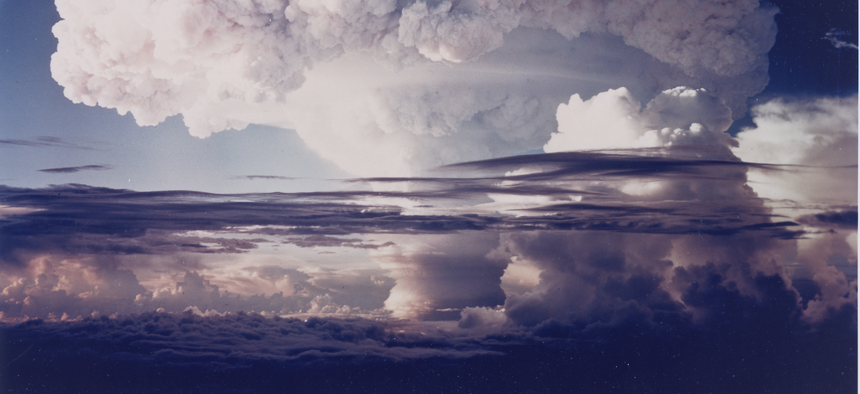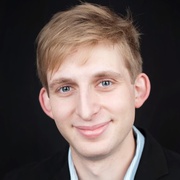
The Doomsday Clock last stood at “two minutes to midnight” in 1953, spurred in part by the “Ivy Mike” thermonuclear test. Department of Energy
Shrugging Toward Doomsday
Experts warn that the world is now as dangerous as it was at the height of the Cold War. Many Americans already know it.
“As of today,” said Rachel Bronson, the president and CEO of the Bulletin of the Atomic Scientists, “it is two minutes to midnight.”
On Thursday, the Bulletin of Atomic Scientists moved the Doomsday Clock—a symbolic assessment of how close the world stands to total destruction—as close to midnight as it has ever been, reflecting the expert group’s “grim assessment” that the world is now “as dangerous as it has been since World War II.”
It is among the most dire warnings ever issued by the Bulletin, whose board of sponsors includes 15 Nobel laureates. Not since 1953, when the United States and Soviet Union both began hydrogen-weapons testing, has the clock been moved so close to the final hour.
Speaking to reporters, experts from the group said that while the Doomsday Clock is based on the risk of many existential threats—like world war, climate change, major epidemics, or new technologies—there was one that outweighed all others this year.
“Unlike in the last few years when we’ve been focusing on both nuclear [weapons] and climate change ... this year the nuclear discussions took center stage in our conversations,” said Bronson. The threat of a nuclear war with North Korea—and the increasingly suspicious atmosphere between China, Russia, and the United States—have lent themselves to a chaotic and destabilized environment.
In their slow and earnest diction, in the way they furrowed their brows and stared out at the small audience, the panel of experts seemed desperate to convey the danger of the present situation. More than one framed the Clock’s assessment as a rebuke to a government suffering from attention deficit disorder, fed a diet of junk by a juvenile news-entertainment complex.
“Ultimately, governments and international institutions—and, to some extent, the media—are not dealing adequately together with the serious global problems we face,” said Lawrence Krauss, a theoretical physicist at Arizona State University and the chair of the Bulletin’s board of scientific sponsors.
“We therefore return again to our plea to the people of the world: If governments are not acting to protect you as they should, you need to take the lead,” he said. “You need to demand action.”
“It’s easier to understand and follow and have opinions about the Kardashians than some of the issues that we’re talking about,” Bronson added. “That in many ways is the power of the Doomsday Clock, in that it gives us a way to talk about whether the world is safer or at greater risk than it was last year ... It gives us a way to talk about these enormously complicated issues in a way that real people can have real conversations.”
This was the third Doomsday announcement that I’ve observed. They’re always confronting events, especially as the Bulletin has grown more and more worried. In 2015, the Bulletin moved the clock to three minutes to midnight, citing the risk of climate change and several national programs to modernize nuclear weapons. Last January, the clock ticked another 30 seconds forward, as the board fretted over the loose nuclear rhetoric of Vladimir Putin and Donald Trump.
But there was something especially dismal about this year’s announcement. Many Americans know that the world has gotten more dangerous in the last few years (which would be true, by the way, no matter who won the 2016 election). But the necessity of daily life—of doing homework, having a career, going to the gym, getting dinner on the table—has compressed that fear into an ignorable background hum. And so the country once known for its can-do spirit has begun to adopt a personality tic more common in besieged cities and late Soviet states: Well, yes, the situation is terrible, but who has time to feel something about it?
How much have we become numb to? China has begun to erect refugee camps on its North Korea border. The U.S. military has started updating and stockpiling crucial matériel in the region. United Nations sanctions are described in the pressas a “last test of whether any amount of economic pressure” can force the country to relent. “Are we preparing plans for a preventive war?” asked H. R. McMaster, the national security adviser, in an August interview. “The president’s been very clear about it. He said he’s not going to tolerate North Korea being able to threaten the United States.”
But North Korea can already threaten the United States. In September, the nation conducted a nuclear test at least 10 times more powerful than any of its previous detonations. Last year it also launched a test missile that many experts believe can reach either coast of the continental United States.
Turn then to Europe, where nato has responded to the Russian invasion of Ukraine by initiating the largest buildup of troops and gear since the 1980s. Just this week, 12 American warplanes and about 375 Air Force troops deployed to Estonia, a nato ally that fears Russian invasion. Lithuania, also in nato, recently updated its civil-defense booklet, advising citizens how to become a post-occupation insurgency; it has also begun to build a $32 million fence along one of its borders with Russia. After a series of Russian submarine hunts in its waters, Sweden reinstated the draft this year, calling up about a third of its 18-year-olds. “I hope I’m wrong, but there’s a war coming,” the U.S. Marine commandant told troops in Norway last month. “We’ve got 300 Marines up here; we could go from 300 to 3,000 overnight.”
A leaked copy of the new U.S. nuclear policy calls for new kinds of nuclear weapons and more weapons overall. In November, the European Union adopted a program of joint military investment and research, the first step toward an independent E.U. military.
For its part, Russia and its ally Belarus moved as many as 100,000 troops only a couple hundred miles from the NATO border in September as part of a quadrennial war game. Just this month, Russia tested a modernized supersonic nuclear bomber, and it is building an autonomous submarine that could patrol distant shores and dispatch thermonuclear torpedoes by remote. Russia has also deployed a ground-based intermediate-range nuclear missile—violating a key 1987 treaty—prompting the United States to soon do the same.
“For some time I have feared that the threat of nuclear disaster has grown beyondthe risk we faced during the darkest years of the Cold War,” William Perry, the former secretary of defense, said in a statement Thursday. “The danger of a nuclear catastrophe is increasingly real.”
Amid this military buildup, President Trump has sometimes waffled on whether the United States would go to war to defend Europe—which many experts believe makes a war in Europe more likely. In April, the president said NATO was “no longer obsolete,” reversing a campaign stance. But one month later, he did not mention NATO’s Article 5—the treaty clause that says an attack on one NATO member is an attack on them all—in a major speech. He only endorsed the collective-defense provision two weeks after that in a press conference.
Amid this global uncertainty, what does President Trump’s government look like? The defense and diplomacy establishment is still missing appointees. More than 100 senior members of the foreign service have left the State Department; Rex Tillerson, the secretary of state, is aiming to cut almost 2,000 career diplomats by October. The National Nuclear Security Administration, the federal agency charged with keeping the nuclear stockpile safe, has also not been fully staffed.
There is no presidential science adviser for the first time in 50 years. The White House Office of Science and Technology Policy has half the staff it once did, most of whom reportedly have no background in science. The U.S. Environmental Protection Agency dismissed dozens of researchers from its nonpartisan scientific advisory boards, then changed the rules governing them to bar most academic scientists from joining. “The official mechanisms to tie public policy to reality are currently absent,” said Krauss, the chair of the Bulletin, on Thursday.
And how is reality doing, by the way? Scientists at NASA and NOAA agreed that 2017 was among the three hottest years ever measured. Seventeen of the 18 warmest years on record have transpired since 2001. NOAA reported that the Arctic shows “no sign” of turning back into a “reliably frozen region.” 2017 was the most expensive year for natural disasters in U.S. history. Global greenhouse-gas emissions are rising, despite years of diplomacy and tepid technological advances in renewable energy. (Meanwhile, President Trump has withdrawn the United States from the ongoing climate diplomatic process.) The amount of carbon in the atmosphere is accelerating faster than emissions, and scientists don’t know why.
The market riots to new highs despite all this, but of course it does—the market thought everything was great in 2007 too. So many Americans go through their lives with a bifurcated mind: Their job is fine, their kids are healthy, and then there’s that other thing, the Big Risk, out there. Only when the two realities crash against each other does it become clear that people know so much is at stake. A few weeks ago, more than 1 million Hawaiians received a phone alert saying a ballistic missile was inbound. These sensible American adults did not respond to the popup by scratching their heads en masse and wondering if someone hacked the system. They called their parents to say they loved them, and they removed manhole covers and told their children to climb in, don’t be afraid.
Millions of Americans have come to expect the unimaginable, but they can’t imagine a way out of the present either. So when a board of experts tells them that catastrophe is at hand, they read the news and think: Yep. And then they wonder what’s for lunch.




